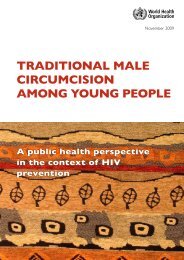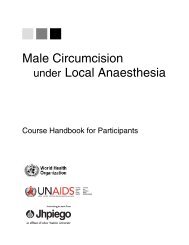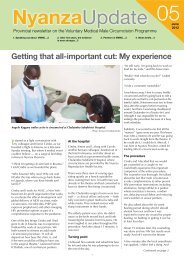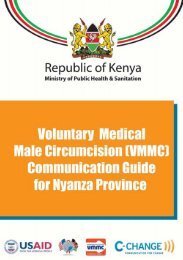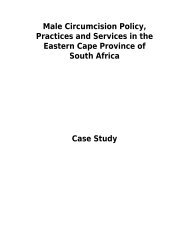Manual for Male Circumcision under Local Anaesthesia
Manual for Male Circumcision under Local Anaesthesia
Manual for Male Circumcision under Local Anaesthesia
You also want an ePaper? Increase the reach of your titles
YUMPU automatically turns print PDFs into web optimized ePapers that Google loves.
<strong>Male</strong> circumcision <strong>under</strong> local anaesthesia Version 2.5C (Jan08)<br />
Suturing<br />
The following are the basic suturing techniques:<br />
Simple interrupted suture. This is the simplest type of stitch, and<br />
results in good apposition. The point of the needle should pass through<br />
the skin at 90 degrees to the skin surface and exit at the same angle<br />
(Fig. 5.5). The nearer to the skin edge the needle goes in, the better<br />
the skin edge apposition but the higher the risk of the stitch cutting out.<br />
If the stitches are placed at a greater distance from the wound edge,<br />
there is a risk of inversion (burying) of the skin edges and poor healing.<br />
For this reason, in male circumcision, a combination of simple and<br />
mattress sutures is recommended.<br />
A<br />
Fig. 5.5 Simple interrupted suture. A: suture in place holding the skin<br />
edges together. B: simple sutures closing the circumcision incision.<br />
Mattress sutures. Mattress sutures give a more precise apposition of<br />
the wound edges and reduce the risk of burying the skin edges. They<br />
are more complex than simple interrupted sutures, and there<strong>for</strong>e more<br />
time-consuming to put in.<br />
Vertical mattress suture<br />
The technique is illustrated in Fig. 5.6.<br />
1. Start the first bite wide of the incision and pass to the same<br />
position on the other side of the wound.<br />
2. Start the second bite on the side of the incision where the needle<br />
has just exited the skin. Pass the needle through the skin between<br />
the exit point and the wound edge, in line with the original entry<br />
point. From this point, take a small bite; the final exit point is in a<br />
similar position on the other side of the wound.<br />
3. Tie the knot so that it does not lie over the incision line. This suture<br />
approximates the subcutaneous tissue and the skin edge.<br />
When suturing the circumcision wound, vertical mattress sutures are<br />
usually placed in the 12 o’clock, 3 o’clock and 9 o’clock positions<br />
(taking the frenulum as the 6 o’clock position).<br />
Surgical procedures <strong>for</strong> adults and adolescents Chapter 5-5<br />
B<br />
<strong>Male</strong> circumcision <strong>under</strong> local anaesthesia Version 2.5C (Jan08)<br />
A<br />
Surgical procedures <strong>for</strong> adults and adolescents Chapter 5-6<br />
B<br />
C D<br />
Amended drawing<br />
To come<br />
Fig. 5.6 Vertical mattress suture. A, B: the technique. C: vertical<br />
mattress suture holding the skin edges and subcutaneous tissues<br />
together. D: A vertical mattress suture in the 9 o’clock position.<br />
Horizontal mattress suture<br />
The technique is illustrated in Fig. 5.7.<br />
1. Make two sutures, aligned beside one another. Align the first stitch<br />
across the wound; begin the second on the side that the first ends.<br />
2. Tie the knot on the side of the original entry point.<br />
A horizontal mattress suture is placed in the 6 o’clock position<br />
(frenulum).<br />
A<br />
C<br />
B<br />
D





